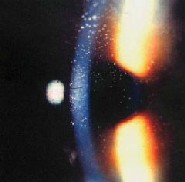Q. What is the origin of mucin balls, and why do we see more of them with silicone hydrogel fits than with other contact lenses? Are there any cornea or tear films that may be predisposed to this condition?
A. Recent studies have shown that mucin balls are likely to be made from collapsed mucin, and that glycoproteins form a major component.1 [Mucin balls] do not have a defined structure at the center. Rather they are formed from naturally occurring mucins at the ocular surface that have collapsed and then gradually coalesce under the rolling motion of the contact lens, says Associate Professor Debbie Sweeney, O.D., Ph.D. of the Cornea and Contact Lens Research Unit at the University of New South Wales in Sydney, Australia.
Two key features of silicone hydrogel lensestheir surface characteristics and intrinsic stiffnesscontribute to the formation of mucin balls, adds Nathan Efron, Ph.D., a clinical professor of optometry in Manchester, England. The low deposition rate of silicone hydrogel materials prevents significant uptake of deposits onto or into the lens matrix during lens wear. The depletion of aqueous during overnight wear results in a viscous, mucin-lipid layer between the lens and epithelial surface, containing much more mucin than lipid.
Silicone hydrogel lenses are thought to induce high interfacial forces. When these forces are coupled with the high elasticity of these lenses, they create a shearing of this layer in the course of movement induced by normal blinking and rapid eye movement, explains Dr. Efron. These forces roll the mucin-rich, post-lens layer into spheres, which are observed as mucin balls.
 |
| Mucin balls observed using indirect marginal retro-illumination. |
One study found a subset of the population is predisposed to mucin balls regardless of lens type. Still, lens type does influence the degree of mucin ball formation.2 Other studies show that mucin balls are associated with steeper corneal curvature, increased lens wettability and increased back surface deposits. It is reasonable to assume that [silicone hydrogel lenses] may have a greater interaction with the corneal surface and that the forces generated may be more pronounced in wearers with steeper corneal curvature, Dr. Sweeney says.
A study of 92 patients wearing lotrafilcon A lenses found that eyes with a steeper corneal curvature were more likely to present with mucin ball debris, indicating they may be a function of lens fit.3 A greater mismatch in shape between the back surface of the lens and the epithelial surface may increase the degree of lens movement over the ocular surface, and thus create more shearing and consequently more mucin balls, Dr. Efron says.
Q. Do mucin balls pose any threat to the ocular surface or to contact lens wear?
A. An association between mucin balls and increased corneal fluorescein staining has been reported.4 Dr. Efron says this is likely due to the remaining mucin balls and fluid-filled epithelial pits staining with fluorescein.
Mucin balls do cause a disruption to the mucous layer of the epithelium. They also cause indentations that extend across the entire corneal surface. Although people with a high number of mucin balls may experience a transient effect on vision, there is no evidence that mucin balls cause any long-term deleterious effects, Dr. Sweeney says. As always, closely monitor any potential disruption to the patients corneal integrity.
Its even possible that this phenomenon may never be detected. Dimples generally resolve rapidly but should be addressed. Try a different type of lens, or try a different base curve in the original material.
1. Millar TJ, Papas EB, Ozkan J, et al. Clinical appearance and microscopic analysis of mucin balls associated with contact lens wear. Cornea 2003 Nov;22(8):740-5.
2. Tan J, Keay L, Jalbert I, et al. Mucin balls with wear of conventional and silicone hydrogel contact lenses. Optom Vis Sci 2003 Apr;80(4):291-7.
3. Dumbleton K, Jones L, Chalmers R, et al. Clinical characterization of spherical post-lens debris associated with lotrafilcon high-Dk silicone lenses. CLAO J 2000 Oct;26(4):186-92.
4. Morgan PB, Efron N. Comparative clinical performance of two silicone hydrogel contact lenses for continuous wear. Clin Exp Optom 2002 May;85(3):183-92.

